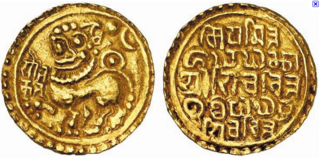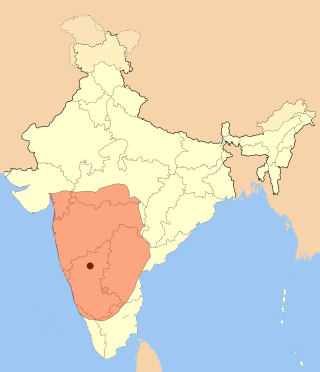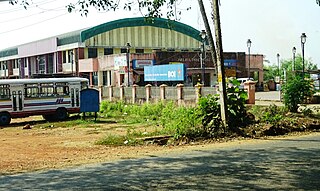
The Kadambas were an ancient royal family of Karnataka, India, that ruled northern Karnataka and the Konkan from Banavasi in present-day Uttara Kannada district. The kingdom was founded by Mayurasharma in c. 345, and at later times showed the potential of developing into imperial proportions. An indication of their imperial ambitions is provided by the titles and epithets assumed by its rulers, and the marital relations they kept with other kingdoms and empires, such as the Vakatakas and Guptas of northern India. Mayurasharma defeated the armies of the Pallavas of Kanchi possibly with the help of some native tribes and claimed sovereignty. The Kadamba power reached its peak during the rule of Kakusthavarma.

Salcete is a subdivision of the district of South Goa, in the state of Goa, situated by the west coast of India. The Sal River and its backwaters dominate the landscape of Salcete. Historically, the sixty-six settlements south of the Zuari River formed the original Salcette territory. Salcete forms a part of the bigger Konkan region that stretches along the western shoreline of peninsular India.
The Konkani people are an Indo-Aryan ethnolinguistic group native to the Konkan region of the Indian subcontinent who speak various dialects of the Konkani language. Konkani is the state language of Goa and also spoken by populations in coastal Karnataka, coastal Maharashtra, and Kerala. Other Konkani speakers are found in Gujarat state. A large percentage of Konkani people are bilingual.

Halasi is a town in Khanapur Taluk, Belgaum District in Karnataka, India. It is 14 km from Khanapur and about 25 km from Kittur. As known from inscriptions, the ancient name of the town was Palāśikā. A centre of the early Kadamba Dynasty, it was a minor capital of the Goa Kadambas (980-1025). The town is notable for a series of medieval temples. The most famous are the Varāha Narasiṃha temple and Suvarṇeśvara temple in the town, and a third temple of Rāmeśvara. On a hill about 1.9 km. south-west of the town is a pilgrimage place known as Rāmatītha.

North Karnataka is a geographical region in Deccan plateau from 300 to 730 metres elevation that constitutes the region of the Karnataka state in India and the region consists of 13 districts. It is drained by the Krishna River and its tributaries the Bhima, Ghataprabha, Malaprabha, and Tungabhadra. North Karnataka lies within the Deccan thorn scrub forests ecoregion, which extends north into eastern Maharashtra.
The island of Divar lies in the Mandovi river in the Indian state of Goa.
Curtorim is a town in the Salcette taluka of South Goa district in Goa, India.It comes under Margao metropolitan region. Curtorim, a verdant agrarian village, known as the "granary of Salcete", is said to have got its name from either kuddtari or kuddtoddi since the agricultural village had kudds (rooms) built on the river bank to store kharif and rabi crops.
Khanapur known as Khanapura is a panchayat town in Belagavi district, Karnataka, India. It is about 26 km from Belagavi. The Khanapur Municipal Council governs the town. Khanapur is the headquarters for Khanapur taluk. The town is on the Belgaum-Panaji National Highway, NH 4A. Khanapur is well connected by train and road to important cities in Karnataka, Goa, and Maharashtra. Kannada is the official language.
Loutolim or LoutulimLottli pronounced:[lɔːʈlĩː], Portuguese: Loutulim) is a large village of South Goa district in the state of Goa, India. It is an important settlement in the Salcete sub-district.
Sattari is a taluka of North Goa district in the state of Goa, India. There are 77 villages and 2 towns in Sattari Taluka. The headquarters of Sattari taluka is Valpoi municipal council. It lies in the north-eastern region of Goa where it is known for its greenery and dense forest. Part of the Western Ghats forms the eastern part of the Sattari Taluka. The Mandovi River is considered to be the lifeline of Sattari. It has a geographical area of 490 km2; the Mhadei Wildlife Sanctuary covers 208 km2 of this area.

The Kadambas of Goa were a dynasty during the Late Classical period on the Indian subcontinent, who ruled Goa from the 10th to the 14th century CE. They took over the territories of the Shilaharas and ruled them at first from Chandor, later making Gopakapattana their capital.
Balakrishna Bhagwant Borkar was a poet from Goa, India.
Chandor is a village in Salcete sub-district of South Goa, in the Indian state of Goa. It lies on the southern bank of the Zuari River and western bank of the Kushavati River.

Mangueshi is a village in Priol, Ponda, Goa, India. Mangueshi/Mangueshim are other variations for the same name.
Devara Hubballii is a village in the Dharwad district of Karnataka, India, located 12 km to the southwest of the city Dharwad. The village was established by Shree Nagabhooshana Shivayogigalu, a direct disciple of Sri Siddharoodha swamiji Hubballi, who first arrived in the 1960s to begin his spiritual service. Because of these religious activities, the village of Gidadububalli became the Devara Hubballi. At present, the village extends its branches throughout the Dharwad district and the Pattiyala and Mantur villages in the Belgaum district. The Shree Ranganatha Temple, built by the Goa Kadamba's emperors, is also located in the village, along with a number of other temples.
Kar is a suffix used after the names of villages along the western coast of India, forming the most common surnames used by the Marathi and Konkani people in Maharashtra, Goa and some parts of Karnataka.

The Chalukya dynasty was a Classical Indian dynasty that ruled large parts of southern and central India between the 6th and the 12th centuries. During this period, they ruled as three related yet individual dynasties. The earliest dynasty, known as the "Badami Chalukyas", ruled from Vatapi from the middle of the 6th century. The Badami Chalukyas began to assert their independence at the decline of the Kadamba kingdom of Banavasi and rapidly rose to prominence during the reign of Pulakeshin II. After the death of Pulakeshin II, the Eastern Chalukyas became an independent kingdom in the eastern Deccan. They ruled from Vengi until about the 11th century. In the western Deccan, the rise of the Rashtrakutas in the middle of the 8th century eclipsed the Chalukyas of Badami before being revived by their descendants, the Western Chalukyas, in the late 10th century. These Western Chalukyas ruled from Kalyani until the end of the 12th century.

Shiroda is a village in Ponda Taluka in South Goa District, Goa, India. The village has a population of 14,112 based on 2001 census data.
Wadi-Talaulim is a village in Ponda taluka of Goa, India. As of 2018, it has a population of 3,800.

Neura is a picturesque village located in the Tiswadi taluka of Goa, India. Known for its charming villas and grand mansions, Neura has a rich historical background. During the reign of the Kadamba dynasty, the village thrived as a bustling hub, primarily due to its Naval quarters. It was also a prominent center for learned Brahmin-Sinais.












